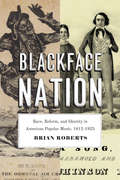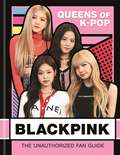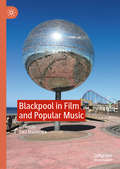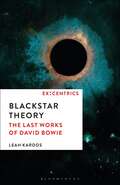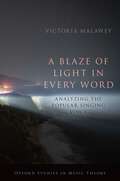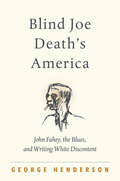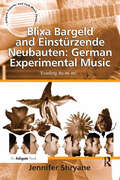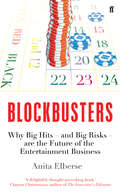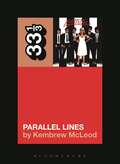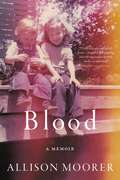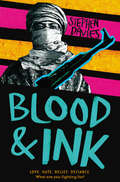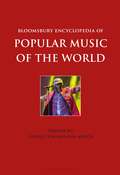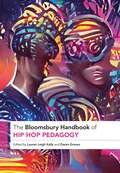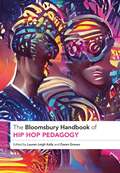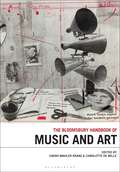- Table View
- List View
Blackface Nation: Race, Reform, and Identity in American Popular Music, 1812-1925
by Brian RobertsAs the United States transitioned from a rural nation to an urbanized, industrial giant between the War of 1812 and the early twentieth century, ordinary people struggled over the question of what it meant to be American. As Brian Roberts shows in Blackface Nation, this struggle is especially evident in popular culture and the interplay between two specific strains of music: middle-class folk and blackface minstrelsy. The Hutchinson Family Singers, the Northeast’s most popular middle-class singing group during the mid-nineteenth century, is perhaps the best example of the first strain of music. The group’s songs expressed an American identity rooted in communal values, with lyrics focusing on abolition, women’s rights, and socialism. Blackface minstrelsy, on the other hand, emerged out of an audience-based coalition of Northern business elites, Southern slaveholders, and young, white, working-class men, for whom blackface expressed an identity rooted in individual self-expression, anti-intellectualism, and white superiority. Its performers embodied the love-crime version of racism, in which vast swaths of the white public adored African Americans who fit blackface stereotypes even as they used those stereotypes to rationalize white supremacy. By the early twentieth century, the blackface version of the American identity had become a part of America’s consumer culture while the Hutchinsons’ songs were increasingly regarded as old-fashioned. Blackface Nation elucidates the central irony in America’s musical history: much of the music that has been interpreted as black, authentic, and expressive was invented, performed, and enjoyed by people who believed strongly in white superiority. At the same time, the music often depicted as white, repressed, and boringly bourgeois was often socially and racially inclusive, committed to reform, and devoted to challenging the immoralities at the heart of America’s capitalist order.
Blackface Nation: Race, Reform, and Identity in American Popular Music, 1812-1925
by Brian RobertsAs the United States transitioned from a rural nation to an urbanized, industrial giant between the War of 1812 and the early twentieth century, ordinary people struggled over the question of what it meant to be American. As Brian Roberts shows in Blackface Nation, this struggle is especially evident in popular culture and the interplay between two specific strains of music: middle-class folk and blackface minstrelsy. The Hutchinson Family Singers, the Northeast’s most popular middle-class singing group during the mid-nineteenth century, is perhaps the best example of the first strain of music. The group’s songs expressed an American identity rooted in communal values, with lyrics focusing on abolition, women’s rights, and socialism. Blackface minstrelsy, on the other hand, emerged out of an audience-based coalition of Northern business elites, Southern slaveholders, and young, white, working-class men, for whom blackface expressed an identity rooted in individual self-expression, anti-intellectualism, and white superiority. Its performers embodied the love-crime version of racism, in which vast swaths of the white public adored African Americans who fit blackface stereotypes even as they used those stereotypes to rationalize white supremacy. By the early twentieth century, the blackface version of the American identity had become a part of America’s consumer culture while the Hutchinsons’ songs were increasingly regarded as old-fashioned. Blackface Nation elucidates the central irony in America’s musical history: much of the music that has been interpreted as black, authentic, and expressive was invented, performed, and enjoyed by people who believed strongly in white superiority. At the same time, the music often depicted as white, repressed, and boringly bourgeois was often socially and racially inclusive, committed to reform, and devoted to challenging the immoralities at the heart of America’s capitalist order.
Blackface Nation: Race, Reform, and Identity in American Popular Music, 1812-1925
by Brian RobertsAs the United States transitioned from a rural nation to an urbanized, industrial giant between the War of 1812 and the early twentieth century, ordinary people struggled over the question of what it meant to be American. As Brian Roberts shows in Blackface Nation, this struggle is especially evident in popular culture and the interplay between two specific strains of music: middle-class folk and blackface minstrelsy. The Hutchinson Family Singers, the Northeast’s most popular middle-class singing group during the mid-nineteenth century, is perhaps the best example of the first strain of music. The group’s songs expressed an American identity rooted in communal values, with lyrics focusing on abolition, women’s rights, and socialism. Blackface minstrelsy, on the other hand, emerged out of an audience-based coalition of Northern business elites, Southern slaveholders, and young, white, working-class men, for whom blackface expressed an identity rooted in individual self-expression, anti-intellectualism, and white superiority. Its performers embodied the love-crime version of racism, in which vast swaths of the white public adored African Americans who fit blackface stereotypes even as they used those stereotypes to rationalize white supremacy. By the early twentieth century, the blackface version of the American identity had become a part of America’s consumer culture while the Hutchinsons’ songs were increasingly regarded as old-fashioned. Blackface Nation elucidates the central irony in America’s musical history: much of the music that has been interpreted as black, authentic, and expressive was invented, performed, and enjoyed by people who believed strongly in white superiority. At the same time, the music often depicted as white, repressed, and boringly bourgeois was often socially and racially inclusive, committed to reform, and devoted to challenging the immoralities at the heart of America’s capitalist order.
Blackpink: K-Pop's No.1 Girl Group
by Adrian BesleyA comprehensive guide to the K-pop girl group who are taking the music world by storm. The sassiest, most stylish girls around – BLACKPINK!‘Blackpink in Your Area!’ The K-pop girl group are taking their catchphrase literally; they have just finished a sell-out stadium world tour. Jisoo, Jennie, Rosé and Lisa, all beautiful and supremely talented women in their early 20s, are the hottest thing in pop right now – and they only have a dozen songs! If Blackpink were ever a secret, the secret was out by April 2019, when they headlined Coachella, and their fandom – known as Blinks – suddenly included Ariana Grande and Harry Styles. They are the first female K-pop group to have had four #1 singles on Billboard's World Digital chart, and their single ‘Ddu-Du Ddu-Du’ became the most viewed music video by a K-pop group on YouTube – take that, BTS!This book is the perfect unofficial guide to Blackpink. It relates their days as trainees, their debut, their hits and success in the US, examines the personalities of each of the members and details their choreography, fashion and style triumphs and reveals why they are ‘the only gang to run the game in high heels’.
BLACKPINK: The Unauthorized Fan Guide
by Helen Brown"BLACKPINK IN YOUR AREA" The must-have commemorative celebration of K-Pop’s biggest girl group.This ultimate fan guide celebrates everything you love about BLACKPINK – the sassiest, most stylish girl group who are taking the music world by storm. Go backstage and relive Jisoo, Jennie, Rosé and Lisa’s incredible experiences, from their days as trainees to the moment they debuted and the worldwide success that followed. Explore the band’s record-smashing music, trendsetting dance moves and fashion triumphs, and celebrate the girls’ different personalities and styles. Once you’ve learnt everything there is to know about the Queens of K-Pop, take the ultimate quiz to prove how much of a fan you really are.Filled with pages of glossy photos, brilliant quotes and sensational secrets, this is the ultimate book for Blinks as well as new fans everywhere.
Blackpool in Film and Popular Music
by Ewa MazierskaThis collection examines Blackpool, Britain’s first and largest working-class seaside resort as a location for the production and consumption of British film and popular music, and the meaning of ‘Blackpool’ in films and songs. It examines representation of Blackpool in films such as Hindle Wakes, A Taste of Honey, Bhaji on the Beach, Away, Bob’s Weekend, The Harry Hill Movie and Miss Peregrine's Home for Peculiar Children, linking it to the concepts of heterotopia, purgatory, fantasy, simulacra and the carnivalesque. It also presents music in Blackpool through the history of its venues and examines development of punk and grime music in this seaside town. The authors argue that Blackpool in filmic and musical texts often stands for British culture, but increasingly for culture which is remembered or imagined rather than present and real.
Blackstar Theory: The Last Works of David Bowie (Ex:Centrics)
by Leah KardosBlackstar Theory takes a close look at David Bowie's ambitious last works: his surprise 'comeback' project The Next Day (2013), the off-Broadway musical Lazarus (2015) and the album that preceded the artist's death in 2016 by two days, Blackstar. The book explores the swirl of themes that orbit and entangle these projects from a starting point in musical analysis and features new interviews with key collaborators from the period: producer Tony Visconti, graphic designer Jonathan Barnbrook, musical director Henry Hey, saxophonist Donny McCaslin and assistant sound engineer Erin Tonkon.These works tackle the biggest of ideas: identity, creativity, chaos, transience and immortality. They enact a process of individuation for the Bowie meta-persona and invite us to consider what happens when a star dies. In our universe, dying stars do not disappear - they transform into new stellar objects, remnants and gravitational forces. The radical potential of the Blackstar is demonstrated in the rock star supernova that creates a singularity resulting in cultural iconicity. It is how a man approaching his own death can create art that illuminates the immortal potential of all matter in the known universe.
Blackstar Theory: The Last Works of David Bowie (Ex:Centrics #2)
by Leah KardosBlackstar Theory takes a close look at David Bowie's ambitious last works: his surprise 'comeback' project The Next Day (2013), the off-Broadway musical Lazarus (2015) and the album that preceded the artist's death in 2016 by two days, Blackstar. The book explores the swirl of themes that orbit and entangle these projects from a starting point in musical analysis and features new interviews with key collaborators from the period: producer Tony Visconti, graphic designer Jonathan Barnbrook, musical director Henry Hey, saxophonist Donny McCaslin and assistant sound engineer Erin Tonkon.These works tackle the biggest of ideas: identity, creativity, chaos, transience and immortality. They enact a process of individuation for the Bowie meta-persona and invite us to consider what happens when a star dies. In our universe, dying stars do not disappear - they transform into new stellar objects, remnants and gravitational forces. The radical potential of the Blackstar is demonstrated in the rock star supernova that creates a singularity resulting in cultural iconicity. It is how a man approaching his own death can create art that illuminates the immortal potential of all matter in the known universe.
A Blaze of Light in Every Word: Analyzing the Popular Singing Voice (Oxford Studies in Music Theory)
by Victoria MalaweyThe human singing voice holds immense power - to convey mood, emotion, and identity in songs, provide music's undeniable "wow" moments, and communicate a pop song's meaning perhaps more than any other musical parameter. And unlike the other aspects of musical content - like harmony, form, melody, and rhythm, for which generations of scholars have formed sophisticated analyses - scholarly approaches to vocal delivery remain grossly underdeveloped. An exciting and much-needed new approach, A Blaze of Light in Every Word presents a systematic and encompassing conceptual model for analyzing vocal delivery. Author Victoria Malawey focuses on three overlapping areas of inquiry - pitch, prosody, and quality - while drawing on research from music theory and pedagogy as well as gender studies and philosophy to situates the sonic and material aspects of vocal delivery among broader cultural, philosophical, and anthropological approaches to voice. Malawey develops a much-needed and innovative set of analytical tools through in-depth analyses of popular song recordings in genres spanning from hip hop to death metal. A Blaze of Light in Every Word brings new clarity to the relationship between the voice's sonic content and its greater signification, helping us understand the complexity and uniqueness of singing voices.
A Blaze of Light in Every Word: Analyzing the Popular Singing Voice (Oxford Studies in Music Theory)
by Victoria MalaweyThe human singing voice holds immense power - to convey mood, emotion, and identity in songs, provide music's undeniable "wow" moments, and communicate a pop song's meaning perhaps more than any other musical parameter. And unlike the other aspects of musical content - like harmony, form, melody, and rhythm, for which generations of scholars have formed sophisticated analyses - scholarly approaches to vocal delivery remain grossly underdeveloped. An exciting and much-needed new approach, A Blaze of Light in Every Word presents a systematic and encompassing conceptual model for analyzing vocal delivery. Author Victoria Malawey focuses on three overlapping areas of inquiry - pitch, prosody, and quality - while drawing on research from music theory and pedagogy as well as gender studies and philosophy to situates the sonic and material aspects of vocal delivery among broader cultural, philosophical, and anthropological approaches to voice. Malawey develops a much-needed and innovative set of analytical tools through in-depth analyses of popular song recordings in genres spanning from hip hop to death metal. A Blaze of Light in Every Word brings new clarity to the relationship between the voice's sonic content and its greater signification, helping us understand the complexity and uniqueness of singing voices.
'Blerwytirhwng?' The Place of Welsh Pop Music
by Sarah HillIn the 1960s, Welsh-language popular music emerged as a vehicle for mobilizing a geographically dispersed community into political action. As the decades progressed, Welsh popular music developed beyond its acoustic folk roots, adopting the various styles of contemporary popular music, and ultimately gaining the cultural self-confidence to compete in the Anglo-American mainstream market. The resulting tensions, between Welsh and English, amateur and professional, rural and urban, the local and the international, necessitate the understanding of Welsh pop as part of a much larger cultural process. Not merely a 'Celtic' issue, the cultural struggles faced by Welsh speakers in a predominantly Anglophone environment are similar to those faced by innumerable other minority communities enduring political, social or linguistic domination. The aim of 'Blerwytirhwng?' The Place of Welsh Pop Music is to explore the popular music which accompanied those struggles, to connect Wales to the larger Anglo-American popular culture, and to consider the shift in power from the dominant to the minority, the centre to the periphery. By surveying the development of Welsh-language popular music from 1945-2000, 'Blerwytirhwng?' The Place of Welsh Pop examines those moments of crisis in Welsh cultural life which signalled a burgeoning sense of national identity, which challenged paradigms of linguistic belonging, and out of which emerged new expressions of Welshness.
'Blerwytirhwng?' The Place of Welsh Pop Music
by Sarah HillIn the 1960s, Welsh-language popular music emerged as a vehicle for mobilizing a geographically dispersed community into political action. As the decades progressed, Welsh popular music developed beyond its acoustic folk roots, adopting the various styles of contemporary popular music, and ultimately gaining the cultural self-confidence to compete in the Anglo-American mainstream market. The resulting tensions, between Welsh and English, amateur and professional, rural and urban, the local and the international, necessitate the understanding of Welsh pop as part of a much larger cultural process. Not merely a 'Celtic' issue, the cultural struggles faced by Welsh speakers in a predominantly Anglophone environment are similar to those faced by innumerable other minority communities enduring political, social or linguistic domination. The aim of 'Blerwytirhwng?' The Place of Welsh Pop Music is to explore the popular music which accompanied those struggles, to connect Wales to the larger Anglo-American popular culture, and to consider the shift in power from the dominant to the minority, the centre to the periphery. By surveying the development of Welsh-language popular music from 1945-2000, 'Blerwytirhwng?' The Place of Welsh Pop examines those moments of crisis in Welsh cultural life which signalled a burgeoning sense of national identity, which challenged paradigms of linguistic belonging, and out of which emerged new expressions of Welshness.
Blind Joe Death's America: John Fahey, the Blues, and Writing White Discontent
by George HendersonFor over sixty years, American guitarist John Fahey (1939–2001) has been a storied figure, first within the folk and blues revival of the long 1960s, later for fans of alternative music. Mythologizing himself as Blind Joe Death, Fahey crudely parodied white middle-class fascination with African American blues, including his own. In this book, George Henderson mines Fahey's parallel careers as essayist, notorious liner note stylist, musicologist, and fabulist for the first time. These vocations, inspired originally by Cold War educators' injunction to creatively express rather than suppress feelings, took utterly idiosyncratic and prescient turns.Fahey voraciously consumed ideas: in the classroom, the counterculture, the civil rights struggle, the new left; through his study of philosophy, folklore, African American blues; and through his experience with psychoanalysis and southern paternalism. From these, he produced a profoundly and unexpectedly refracted vision of America. To read Fahey is to vicariously experience devastating critical energies and self-soothing uncertainty, passions emerging from a singular location—the place where lone, white rebel sentiment must regard the rebellion of others. Henderson shows the nuance, contradictions, and sometimes brilliance of Fahey's words that, though they were never sung to a tune, accompanied his music.
Blixa Bargeld and Einstürzende Neubauten: 'Evading do-re-mi' (Ashgate Popular and Folk Music Series)
by Jennifer ShryaneAt the end of his life, Pierre Schaeffer commented that his musical and sound experiments had attempted to go beyond 'do-re-mi'. This had a direct bearing on Einstürzende Neubauten's musical philosophy and work, with the musicians always striving to extend the boundaries of music in sound, instrumentation and purpose. The group are one of the few examples of 'rock-based' artists who have been able to sustain a breadth and depth of work in a variety of media over a number of years while remaining experimental and open to development. Jennifer Shryane provides a much-needed analysis of the group's important place in popular/experimental music history. She illustrates their innovations with found- and self-constructed instrumentation, their Artaudian performance strategies and textual concerns, as well as their methods of independence. Einstürzende Neubauten have also made a consistent and unique contribution to the development of the independent German Language Contemporary Music scene, which although often acknowledged as influential, is still rarely examined.
Blixa Bargeld and Einstürzende Neubauten: 'Evading do-re-mi' (Ashgate Popular and Folk Music Series)
by Jennifer ShryaneAt the end of his life, Pierre Schaeffer commented that his musical and sound experiments had attempted to go beyond 'do-re-mi'. This had a direct bearing on Einstürzende Neubauten's musical philosophy and work, with the musicians always striving to extend the boundaries of music in sound, instrumentation and purpose. The group are one of the few examples of 'rock-based' artists who have been able to sustain a breadth and depth of work in a variety of media over a number of years while remaining experimental and open to development. Jennifer Shryane provides a much-needed analysis of the group's important place in popular/experimental music history. She illustrates their innovations with found- and self-constructed instrumentation, their Artaudian performance strategies and textual concerns, as well as their methods of independence. Einstürzende Neubauten have also made a consistent and unique contribution to the development of the independent German Language Contemporary Music scene, which although often acknowledged as influential, is still rarely examined.
Blockbusters: Why Big Hits – and Big Risks – are the Future of the Entertainment Business
by Anita ElberseWhat is behind the phenomenal success of entertainment businesses such as Warner Bros., Marvel Enterprises and Manchester United - along with such stars as Jay-Z and Lady Gaga? Which strategies give leaders in film, television, music, publishing, and sports an edge over their rivals? Anita Elberse, Harvard Business School's expert on the entertainment industry, has done pioneering research on the worlds of media and sports for more than a decade. Now, in this groundbreaking book, she explains a powerful truth about the fiercely competitive world of entertainment: building a business around blockbuster products - the movies, television shows, songs and books that are hugely expensive to produce and market - is the surest path to long-term success. Along the way, she reveals why entertainment executives often spend outrageous amounts of money in search of the next blockbuster, why superstars are paid unimaginable sums and how digital technologies are transforming the entertainment landscape. Full of inside stories emerging from her unprecedented access to some of the world's most successful entertainment brands, Blockbusters is destined to become required reading for anyone seeking to understand how the entertainment industry really works - and how to navigate today's high-stakes business world at large. 'Convincing . . . Elberse's Blockbusters builds on her already impressive academic r�sum� to create an accessible and entertaining book.' Financial Times
Blondie's Parallel Lines (33 1/3)
by Kembrew McLeodBlondie's Parallel Lines mixed punk, disco and radio-friendly FM rock with nostalgic influences from 1960s pop and girl group hits. This 1978 album kept one foot planted firmly in the past while remaining quite forward-looking, an impulse that can be heard in its electronic dance music hit "Heart of Glass.†? Bubblegum music maven Mike Chapman produced Parallel Lines, which was the first massive hit by a group from the CBGB punk underworld. By embracing the diversity of New York City's varied music scenes, Blondie embodied many of the tensions that played out at the time between fans of disco, punk, pop and mainstream rock. Debbie Harry's campy glamor and sassy snarl shook up the rock'n'roll boy's club during a growing backlash against the women's and gay liberation movements, which helped fuel the "disco sucks†? battle cry in the late 1970s. Despite disco's roots in a queer, black and Latino underground scene that began in downtown New York, punk is usually celebrated by critics and scholars as the quintessential subculture. This book challenges the conventional wisdom that dismissed disco as fluffy prefab schlock while also recuperating punk's unhip pop influences, revealing how these two genres were more closely connected than most people assume. Even Blondie's album title, Parallel Lines, evokes the parallel development of punk and disco-along with their eventual crossover into the mainstream.
Blondie's Parallel Lines (33 1/3)
by Kembrew McLeodBlondie's Parallel Lines mixed punk, disco and radio-friendly FM rock with nostalgic influences from 1960s pop and girl group hits. This 1978 album kept one foot planted firmly in the past while remaining quite forward-looking, an impulse that can be heard in its electronic dance music hit “Heart of Glass.” Bubblegum music maven Mike Chapman produced Parallel Lines, which was the first massive hit by a group from the CBGB punk underworld. By embracing the diversity of New York City's varied music scenes, Blondie embodied many of the tensions that played out at the time between fans of disco, punk, pop and mainstream rock. Debbie Harry's campy glamor and sassy snarl shook up the rock'n'roll boy's club during a growing backlash against the women's and gay liberation movements, which helped fuel the “disco sucks” battle cry in the late 1970s. Despite disco's roots in a queer, black and Latino underground scene that began in downtown New York, punk is usually celebrated by critics and scholars as the quintessential subculture. This book challenges the conventional wisdom that dismissed disco as fluffy prefab schlock while also recuperating punk's unhip pop influences, revealing how these two genres were more closely connected than most people assume. Even Blondie's album title, Parallel Lines, evokes the parallel development of punk and disco-along with their eventual crossover into the mainstream.
Blood: A Memoir
by Allison MoorerThe Grammy- and Academy Award- nominated singer-songwriter's haunting, lyrical memoir, sharing the story of an unthinkable act of violence and ultimate healing through artMobile, Alabama, 1986. A fourteen-year-old girl is awakened by the unmistakable sound of gunfire. On the front lawn, her father has shot and killed her mother before turning the gun on himself. Allison Moorer would grow up to be an award-winning musician, with her songs likened to "a Southern accent: eight miles an hour, deliberate, and very dangerous to underestimate" (Rolling Stone). But that moment, which forever altered her own life and that of her older sister, Shelby, has never been far from her thoughts. Now, in her journey to understand the unthinkable, to parse the unknowable, Allison uses her lyrical storytelling powers to lay bare the memories and impressions that make a family, and that tear a family apart.Blood delves into the meaning of inheritance and destiny, shame and trauma -- and how it is possible to carve out a safe place in the world despite it all. With a foreword by Allison's sister, Grammy winner Shelby Lynne, Blood reads like an intimate journal: vivid, haunting, and ultimately life-affirming.
Blood: A Memoir
by Allison MoorerThe Grammy- and Academy Award- nominated singer-songwriter's haunting, lyrical memoir, sharing the story of an unthinkable act of violence and ultimate healing through artMobile, Alabama, 1986. A fourteen-year-old girl is awakened by the unmistakable sound of gunfire. On the front lawn, her father has shot and killed her mother before turning the gun on himself. Allison Moorer would grow up to be an award-winning musician, with her songs likened to "a Southern accent: eight miles an hour, deliberate, and very dangerous to underestimate" (Rolling Stone). But that moment, which forever altered her own life and that of her older sister, Shelby, has never been far from her thoughts. Now, in her journey to understand the unthinkable, to parse the unknowable, Allison uses her lyrical storytelling powers to lay bare the memories and impressions that make a family, and that tear a family apart.Blood delves into the meaning of inheritance and destiny, shame and trauma -- and how it is possible to carve out a safe place in the world despite it all. With a foreword by Allison's sister, Grammy winner Shelby Lynne, Blood reads like an intimate journal: vivid, haunting, and ultimately life-affirming.
Blood & Ink
by Stephen DaviesKadija is the music-loving daughter of a guardian of the sacred manuscripts of the ancient city of Timbuktu, Mali.Ali is a former shepherd boy, trained as a warrior for Allah.Tonight, the Islamist rebels are coming for Timbuktu. They will install a harsh regime of law and tear apart the peaceful world within the mud walls of the city. Television, football, radios, even music, will be banned. Kadija refuses to let go of her former life. And something in her defiance draws Ali to her.Which path will he choose?
Bloomsbury Encyclopedia of Popular Music of the World, Volume 12: Genres: Sub-Saharan Africa (Encyclopedia of Popular Music of the World)
by Heidi Feldman Gabrielle Kielich John Shepherd David HornThe EPMOW Genre volumes contain entries on the genres of music that have been or currently are popular in countries and communities all over the world. Included are discussions on cultural, historical and geographic origins; technical musical characteristics; instrumentation and use of voice; lyrics and language; typical features of performance and presentation; historical development and paths and modes of dissemination; influence of technology, the music industry and political and economic circumstances; changing stylistic features; notable and influential performers; and relationships to other genres and sub-genres.This volume, on the music of Sub-Saharan Africa, features a wide range of entries and in-depth essays. All entries conclude with a bibliography, discographical references and discography, with additional information on sheet music listings and visual recordings. Written and edited by a team of distinguished popular music scholars and professionals, this is an exceptional resource on the history and development of popular music.
The Bloomsbury Handbook of Hip Hop Pedagogy (Bloomsbury Handbooks)
by Lauren Leigh Kelly and Daren GravesThe Bloomsbury Handbook of Hip Hop Pedagogy is the first reference work to cover the theory, history, research methodologies, and practice of Hip Hop pedagogy. Including 20 chapters from activist-oriented and community engaged scholars, the handbook provides perspectives and studies from across the world, including Brazil, the Caribbean, Scandinavia, and the USA. Organized into four topical sections focusing on the history and cultural roots of Hip Hop; theories and research methods in Hip Hop pedagogy; and Hip Hop pedagogy in practice, the handbook offers theoretical, analytical, and pedagogical insights emerging across sociology, literacy, school counselling and youth organizing. The chapters reflect the impact of critical Hip Hop pedagogies and Hip Hop-based research for educators and scholars interested in radical, transformative approaches to education. Ultimately, the many voices included in the handbook show that Hip Hop pedagogy is a humanizing and emancipatory approach which is redefining the purposes and practices of education.
The Bloomsbury Handbook of Hip Hop Pedagogy (Bloomsbury Handbooks)
The Bloomsbury Handbook of Hip Hop Pedagogy is the first reference work to cover the theory, history, research methodologies, and practice of Hip Hop pedagogy. Including 20 chapters from activist-oriented and community engaged scholars, the handbook provides perspectives and studies from across the world, including Brazil, the Caribbean, Scandinavia, and the USA. Organized into four topical sections focusing on the history and cultural roots of Hip Hop; theories and research methods in Hip Hop pedagogy; and Hip Hop pedagogy in practice, the handbook offers theoretical, analytical, and pedagogical insights emerging across sociology, literacy, school counselling and youth organizing. The chapters reflect the impact of critical Hip Hop pedagogies and Hip Hop-based research for educators and scholars interested in radical, transformative approaches to education. Ultimately, the many voices included in the handbook show that Hip Hop pedagogy is a humanizing and emancipatory approach which is redefining the purposes and practices of education.
The Bloomsbury Handbook of Music and Art (Bloomsbury Handbooks)
by Sarah Mahler Kraaz and Charlotte de MilleThis volume brings together prominent scholars, artists, composers, and directors to present the latest interdisciplinary ideas and projects in the fields of art history, musicology and multi-media practice. Organized around ways of perceiving, experiencing and creating, the book outlines the state of the field through cutting-edge research case studies. For example, how does art-music practice / thinking communicate activist activities? How do socio-economic and environmental problems affect access to heritage? How do contemporary practitioners interpret past works and what global concerns stimulate new works? In each instance, examples of cross or inter-media works are not thought of in isolation but in a global historical context that shows our cultural existence to be complex, conflicted and entwined. For the first time cross-disciplinary collaborations in ethnomusicology-anthropology, ecomusicology-ecoart-ecomuseology and digital humanities for art history, musicology and practice are prioritized in one volume.
